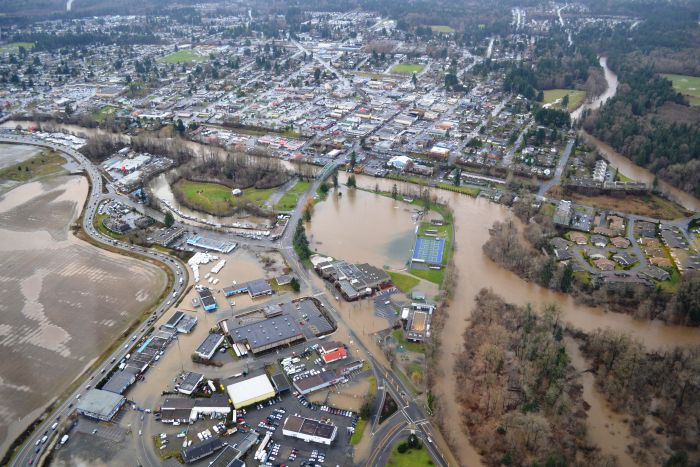LOOK AT DEVELOPMENT DIFFERENTLY: Comox Valley Eco-Asset Management Symposium – Discovering Nature’s Infrastructure Potential (on March 14-15, 2017)
Note to Reader:
The Comox Valley on Vancouver Island is facing a long list of challenges as more frequent and intense winter storms and summer droughts overwhelm engineered infrastructure and natural systems (that have been degraded over time by land use activities). It is feast AND famine! Now, the four local governments in the valley are facing a total cost approaching $200 million for proposed engineered infrastructure solutions to these problems.
On March 14-15, the 22 environmental and ratepayer groups comprising the Comox Valley Conservation Partnership are hosting a symposium to explore less expensive ‘design with nature’ solutions. Sponsors include the City of Courtenay, Comox Valley Regional District, Village of Cumberland and Real Estate Foundation of BC. The symposium spotlight will be on the potentially powerful and cost-effective role that ecosystem services can play in an infrastructure strategy.

THINK GLOBAL & ACT LOCAL: Warming of the atmosphere increases the volume of vapour conveyed by “atmospheric rivers” such as the Pineapple Express. The physics are straightforward: 7% additional water volume for each degree of temperature rise. This is the global part. At the local level in BC, climate change adaptation is very much about water management on the ground. If communities are serious about ensuring RESILIENCY, then the critical strategies and actions are those that relate to water.
To protect watershed health, engineered infrastructure ought to fit into natural systems, rather than the other way around
“The stewardship and conservation sector has traditionally focused on habitat restoration and protection of lands with high ecological values,” states David Stapley, Program Manager with the Comox Valley Conservation Partnership. “With cumulative impacts from climate change, urban and resource development escalating, these  groups have now become community leaders in educating and supporting improved land use practices.”
groups have now become community leaders in educating and supporting improved land use practices.”
“To address these escalating challenges, the Eco-Assets Symposium will promote measures that capture the value of ecological assets to address infrastructure and climate change issues by integrating them into land use planning and practice.”
To Learn More:
Visit http://www.cvlandtrust.ca/eco-assets-symposium.html
Moment of Truth for a Changing Climate
One of the Symposium keynote speakers is Bob Sandford. He is the Chair for Water and Climate Security, United Nations University Institute for Water, Environment and Health. Bob will describe the changing climate and provide suggestions as to what  effects we can expect in a future Comox Valley climate.
effects we can expect in a future Comox Valley climate.
“To make the right choices moving forward, we must understand how and where the rhythms of water are changing. Then we can apply ecosystem-based understanding to adapt our practices to suit a changing climate,” wrote Bob Sandford in a recent Op-Ed article published in the Vancouver Sun newspaper.
“Time is of the essence. Recently identified and potentially dangerous phenomena, such as atmospheric rivers, demand our full attention. An atmospheric river is a narrow corridor of concentrated water vapour aloft. The best known of these great rivers is the famous Pineapple Express.”
“Until we stabilize the composition of the Earth’s atmosphere, phenomena such as atmospheric rivers are likely to cause greater flooding and related economic damage widely – forever making sustainability and adaptive resilience a moving target. So what will we do?”
To Learn More:
Download https://waterbucket.ca/cfa/files/2017/01/Op-Ed_Stephens-et-al_23Jan2017_as-published-online.pdf

CAUSE-AND-EFFECT: City of Courtenay Flood, Dec 2014. This photograph shows the result when an atmospheric river event, land use and resource development impacts combine.
Sustainable Watershed Systems,
through Asset Management
The Symposium will introduce participants to a whole-system, water balance approach for restoration of watershed health. Sustainable Watershed Systems, through Asset Management is based on this premise: natural watershed systems are infrastructure assets – we must manage and protect them as such.
UPPER, MID AND LOWER COMOX VALLEY WATERSHEDS:
“The purpose of the Symposium is to build local knowledge and interest in how to apply eco-asset management principles at the local level. The Symposium is very much about setting in motion a mind-set change. It is therefore essential that everyone steps back and sees the big picture,” states Tim Ennis, Executive Director, Comox Valley Land Trust.
essential that everyone steps back and sees the big picture,” states Tim Ennis, Executive Director, Comox Valley Land Trust.
“The climate is changing and the valley is at a cross-roads. An over-arching issue is the impact of various land uses on the natural water cycle. In the upper watershed, it is due to resource-based activities. Moving down the watershed, impacts result from agriculture and urban development, respectively.”
“The Symposium is structured around a series of workshop segments that will assess natural systems opportunities in the upper, mid and lower watersheds. Educational outcomes are modest. The Symposium will be a success if participants understand the concept to ‘think like a watershed’, believe that it can be done, and commit to playing a role so that it will happen.”
“Benefits of the whole-system approach would include less flooding, less stream erosion, and more streamflow during dry weather when needed most. These water balance benefits ultimately translate into lower life-cycle costs and a water-resilient future!”
COLLABORATION ACROSS SECTORS:
Understanding and valuing ecosystem services is a key component in moving forward with the vision for Asset Management for Sustainable Service Delivery: A BC Framework. Local government collaboration through the Georgia Basin Inter-Regional Educational Initiative is producing tools and resources that will help communities integrate water balance solutions into land use decisions.
“Broadening collaboration to include the stewardship, conservation and industry sectors would build understanding and improve practises in the field,” concludes David Stapley. “The Eco-Asset Symposium will provide an opportunity for land use professionals, stewards, local governments, First Nations and Industry to come together to learn, collaborate and identify actions to move water balanced, whole system, eco-asset management solutions forward.”
To Learn More:

Sustainable Watershed Systems would be the outcome in Step Three. But it is not a wait-and-see proposition. Even as local governments are progressing through Steps One and Two for their core infrastructure, they need to be laying the groundwork so that they would be ready to implement Step Three.

